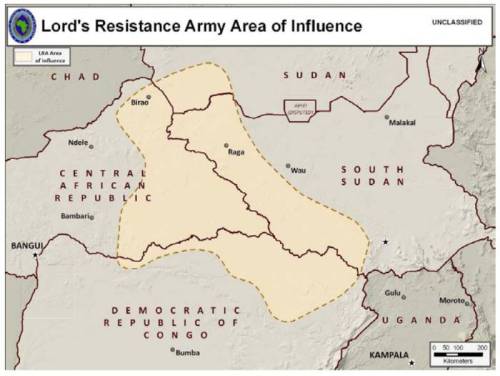Recent US Counter-Terrorism Operations
Operation Observant Compass
Primary Operating Location: Entebbe, Uganda
Secondary Operating Location/s: Counter-LRA Operations Fusion Center (COFC), Obo, CAR; Dungu, Democratic Republic of Congo; Nzara, South Sudan
Assigned Units:
– Special Operations Command Forward – Central Africa (SOCFWD-CA)
– U/I Special Operations Aviation Detachment
Start Date: October 2011
End Date: Ongoing (as of 2013)
Summary: On 24 May 2010, President Barack Obama announced that he had signed the Lord’s Resistance Army Disarmament and Northern Uganda Recovery Act of 2009 into law. The bill recognized and strengthened US commitments and capabilities to protect and assist civilians in areas where the LRA were operating, to receive those LRA members who surrendered, and to support efforts to bring the LRA leadership to justice. US policy was to support a comprehensive and lasting resolution to the conflict in Uganda and neighboring countries. This initially included the Central African Republic (CAR), the Democratic Republic of Congo (DRC), and Sudan. On 9 July 2011, South Sudan formally declared its independence from Sudan, becoming a party to the Counter-LRA (C-LRA) efforts. The rest of Sudan was unaffected by LRA activities. In early 2013, a coup in CAR significantly disrupted C-LRA efforts in that country, which was the location of an intelligence fusion center feeding information to the operation. US policy was also to conduct C-LRA efforts only in cooperation with local authorities and through multilateral efforts.
President Barack Obama further outlined US C-LRA policy in November 2011, indicating that the plan had 4 objectives that supported regional and multilateral efforts: (a) increase protection of civilians; (b) apprehend or remove from the battlefield Joseph Kony and senior commanders; (c) promote the defection, disarmament, demobilization, and reintegration of remaining LRA fighters; and (d) increase humanitarian access and provide continued relief to affected communities. The plan would also be an interagency effort, involving resources from the Department of Defense, Department of State, the Agency for International Development, and the Intelligence Community.
In line with this policy, on 12 October 2011, President Barack Obama announced that he had authorized the deployment of combat-equipped US forces, said to be primarily US special operations forces personnel, to central Africa to support regional C-LRA efforts. These personnel, provided by Special Operations Command and Control Element – Horn of Africa (SOCCE-HOA), an element of US Africa Command’s (AFRICOM) Combined Joint Task Force – Horn of Africa (CJTF-HOA), would advise and assist local security forces in their operations against the LRA. The US had previously assisted with C-LRA efforts in the region during the abortive Ugandan-led offensive in the Garamba National Park in 2008-2009, codenamed by the Ugandans as Operation Lightning Thunder. On 25 October 2011, Alexander Vershbow, assistant secretary of defense for international security affairs, told the House Foreign Affairs Committee that forces deployed to support C-LRA efforts would remain in the region for months, not years. After the unspecified period, however, the advisors would report on whether significant progress had been made and then a decision would be made on whether or not there would be a continuing commitment. The decision was subsequently made to continue to support operations on a more protracted basis.
As part of Operation Observant Compass, the US not only worked to improve the capabilities of the security forces in the four countries affected, but also provided critical support not readily available to them. This came primarily in the form of aviation and intelligence support.
US Air Force Special Operations Command C-145 aircraft (the US designation for the Polish M-28 Skytruck aircraft) provided the ability to rapidly shuttle personnel and supplies around the various forward operating locations. In October 2013, it was reported that a request had been made to bolster this force with CV-22B Osprey aircraft, likely from the contingent that had arrived in Germany to joint Special Operations Command, Europe earlier in the year. In addition, in July 2012, the US Army had issued a Request for Proposals for contractor rotary-wing (helicopter) air support for Operation Observant Compass. In July 2013, Transportation Command assumed responsibility for the award of this contract and issued a Request for Information regarding both rotary-wing and fixed wing air support, issuing a solicitation for bids for both contracts in September 2013.
Intelligence support came primarily in the tasking of strategic and theater assets to provide critical information. This included notably the tasking of aircraft operating under the codename Tusker Sand to conduct overflights of the region from their forward operating location at Entebbe in Uganda. The information gathered by these overflights was in turn passed on to forces conducting C-LRA efforts by way of the Kampala Combined Intelligence Fusion Center (KCIFC).
In mid-2013, there appears to have been a change in the nomenclature for the special operations task force affiliated with this mission. The 2014 Special Operations Command Fact Book lists the task force as “Special Operations Command Forward-Central (AFRICOM Counter-Lord’s Resistance Army Control Element),” but other sources indicate that it should in fact be “Special Operations Command Forward – Central Africa,” which is also abbreviated SOCFWD-CA. This change appears to be part of a plan to streamline the nomenclature for Special Operations Command Africa’s (SOCAFRICA) task forces on the continent as a whole.
For additional information, visit GlobalSecurity.org

